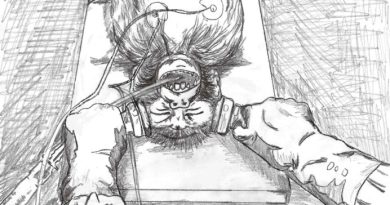Ten Ways Animals are Traumatized in PTSD Experiments
CAARE’s report, From Trauma to Treatment, details the sweeping failure of PTSD experiments on animals to help patients, in contrast to existing, effective treatments and modalities for human-based research.
Yet despite the existence of highly successful therapies to treat PTSD, only 10% of patients currently receive them.
Rather than bridge this gap in access to care, millions of government dollars continue to fund appalling experiments that intentionally traumatize animals, claiming to study PTSD.
To do this, scientists confine, torment and terrorize sentient animals to create what they call “animal models” of PTSD.
Listed below are 10 of these heinous experiments that are so standardized, researchers have designated names for them.* Keep in mind that for PTSD research, these procedures are typically carried repeatedly.
1. Tail suspension involves hanging mice and rats upside down by taping their tails to a board, where they are left hanging as they struggle to escape. Desperate animals may try to climb their tails. Some researchers will insert the tail into a small plastic cylinder to prevent this. They are left hanging until they stop struggling, which researchers claim demonstrates despair. Many animals will experience skin injury on their tails from repeated use of tape.

2. Foot shocks are delivered in rapid succession by placing the victim in a chamber with a metal floor grid and shocking him or her repeatedly. Animals quickly learn to associate trauma with the box, exhibiting signs of fear like crouching and rapid breathing.
3. In underwater trauma, animals are placed in an inescapable tank of water and forced to swim helplessly with no resting platforms or sides to cling to. After this, they are then submerged and held underwater in a metal net for 30 seconds. This slow suffocation is analogous to torture. Researchers tout that this induces intense trauma because the animals believe they are going to drown.


4. During social defeat experiments, smaller male hamsters or mice are placed in close quarters with larger, aggressive males who fight them. This savagery is repeated over a period of time, causing the victimized animal to lose weight or exhibit other fearful behavior.
5. In housing instability, researchers destroy animals’ nests to stress the mothers to such an extent that they are unable to care for their young. Babies often die from hypothermia, starvation or neglect.

6. Animals are subjected to predator exposure, in which they are either directly attacked by cats, snakes or ferrets, or placed in a small enclosure near predators. Sometimes they may be exposed to predator odors such as urine. This method causes intense fear and stress. A rat who has been exposed to a cat for just five minutes will still exhibit anxiety three weeks later.
7. Single prolonged stress and restraint stress are sickening procedures that involve terrifying animals in multiple, successive ways. First restrained for several hours, often in tubes so tight they are completely immobilized, animals are then forced to swim for twenty minutes before being exposed to ether vapors, rendering them unconscious. The process is then repeated a few days later.

8. Aptly titled early life stress, another form of abusive social stress involves removing babies from their mothers for three hours a day during their first three weeks of life. This cruelty permanently alters normal brain development. In many cases baby mice and rats simply die without maternal care.
9. In long-term social isolation experiments, animals are placed in solitary confinement for prolonged periods of time and deprived of any social contact. Animals who are traumatized this way exhibit constant pacing, repetitive movements and sometimes aggression. Just three or four weeks of social isolation has shown to cause long-term fear in mice.

10. Finally, chronic stress consists of constant disruptions and life-threatening challenges used to terrorize animals. This can include extended exposure to loud noise, repeated and unpredictable electrical shocks, food and water deprivation, forced swims in freezing water, heat stresses, vigorous shaking for hours and the reversal of day and night light cycles.
Creating “animal models” for PTSD is not only barbaric, it is also fundamentally flawed. Studies show that more than 90% of neurobiology research using animals fails to apply to human medicine or treatment.
CAARE is calling on federal agencies that fund PTSD experiments: Veteran’s Affairs, National Institutes of Health and Department of Defense, to stop supporting these experiments and redirect those funds to human treatments. Please sign the letter above and add your voice.
Thank you for speaking out for animals in labs!
* References
Schöner, Johanna, Andreas Heinz, Matthias Endres, Karen Gertz, and Golo Kronenberg. “Post‐traumatic stress disorder and beyond: an overview of rodent stress models.” Journal of Cellular and Molecular Medicine (2017). https://www.ncbi.nlm.nih.gov/pmc/articles/PMC5618668/
Goswami, Sonal, Olga Rodríguez-Sierra, Michele Cascardi, and Denis Paré. “Animal models of post-traumatic stress disorder: face validity.” Frontiers in neuroscience 7 (2013): 89. and Zovkic, Iva B., and J. David Sweatt. “Epigenetic mechanisms in learned fear: implications for PTSD.” Neuropsychopharmacology 38, no. 1 (2013): 77-93. https://doi.org/10.3389/fnins.2013.00089
Whitaker, Annie M., Nicholas W. Gilpin, and Scott Edwards; 2014 (September); “Animal Models of Post-Traumatic Stress Disorder and Recent Neurobiological Insights.” Behavioural Pharmacology; 25(5–6): 398–409; https://doi.org/10.1097/FBP.0000000000000069; pdf available at https://www.ncbi.nlm.nih.gov/pmc/articles/PMC4163927/
To take action by sending an email letter, click the button below.
From caare: Citizens for Alternatives to Animal Research and Experimentation. Posted by Jennifer Hunter.





